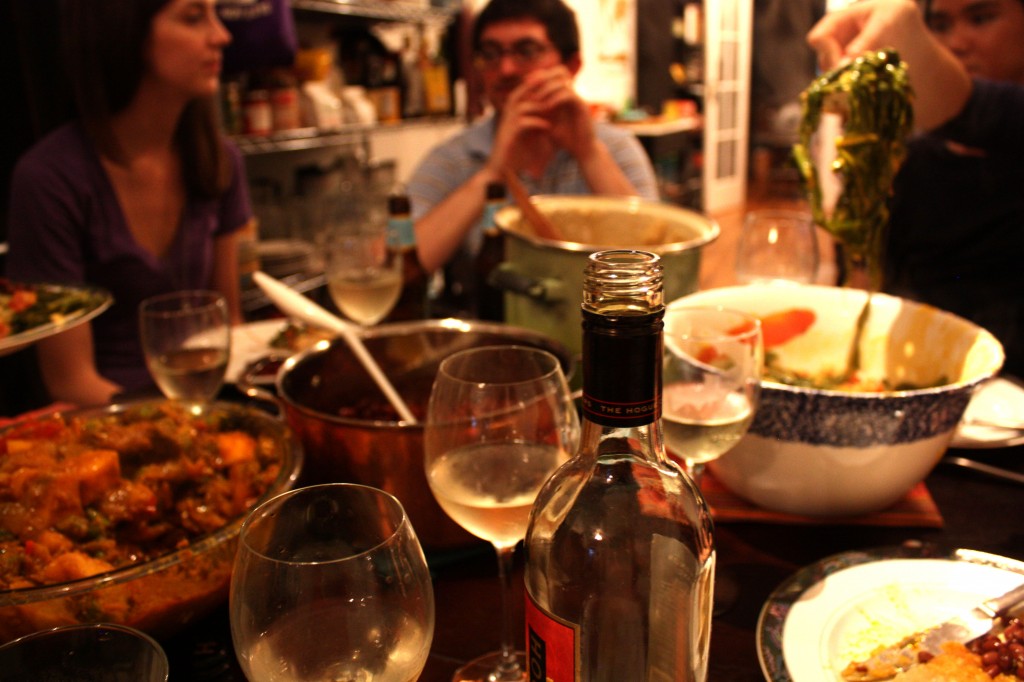What's stewed and tasty and red all over? Angolan food! Just about everything tonight was drenched in highly saturated, boldly colored, and distinctly strong and nutty-tasting red palm oil.
This was the first meal that required venturing out of my normal shopping sphere. I found the red palm oil, palmnut concentrate, and cassava flour for the meal at an African market at Franklin and Fulton, which had very few items I'd ever seen before, but will probably get familiar with over the next few years — given the fact that the ingredients came from Ghana, I wouldn't be surprised if the food all along the West African coast was pretty similar in terms of base ingredients.
Today's guests featured Laura's friends and classmates from school, Iva, Nathan, and Flonia (and her boyfriend Diem), as well as Jessica and Kendal.
So, let's get cooking!
Muamba de Galinha | Chicken in palmnut sauce | Recipe
Chicken with tomatoes, pumpkin, and okra, fried in that red palm oil and thickened with palmnut concentrate. Rich, just a bit spicy, and pretty darn yummy. A very respectable and tasty national dish, with abundant leftovers.
Fumbua | Greens with palm oil and peanut | Recipe
I love recipes that give some background and not just instructions, so cooking this dish was a delight. But perhaps more importantly, it turned out really darn well. I never would have thought of mixing rich greens with a peanut sauce, but now that I have, I recommend you try it too someday. Compared to the palmnut, peanuts seem so light!
Palm Oil Beans | Recipe
I like the lady who sells beans and grains at our local Sunday farmers market. Today she was spinning poi when I showed up, and she helped me find my way to the red merlot beans, so called because their taste is smooth as wine. I won't disagree: these beans were tasty, and took very well to the dousing of palm oil they received at the end.
Funje | Cassava flour porridge | Recipe
Any recipe that requires you to sit on the floor is worth trying once, right? Now I can say I've poured grain into a towel-wrapped pot of just-boiled water, and held it steady with my feet while pounding it with an oar. Well, if I ever do it again, I'll wear socks and long pants, because it splatters! It really looked pretty unappetizing, but such a rich set of dishes does well for a bland, highly absorbent starch. We were all surprised when we ended up going for seconds of funje. (Interesting note: this is also the staple starch of our next country, Antigua and Barbuda, they call it by the same name but use corn instead of cassava.)
Cocada Amarela | Yellow coconut pudding | Recipe
This one really didn't turn out right. Our thermometer seems to not work (boiling liquid registered at about 180°), so we couldn't judge when it got to the right temperature, and then the recipe had me have the heat too high when I added the yolks so it all curdled. Oh well. It's still kind of yummy when you combine fresh coconut, sugar, and egg yolks. And we all enjoyed it when Nathan, who just came back from six months in Micronesia, schooled us on how to crack a coconut.
Excluding dessert, it was quite a success. Even the vegans had a decent meal of it, since I left the salt fish out of the greens. Angolan music was streaming (which sounds a lot like Brazilian music, not surprising given colonial history), beer and wine was flowing, and some very friendly cats happily nosed around the table.
We're crossing the Atlantic to the Caribbean nation of Antigua and Barbuda next week.
